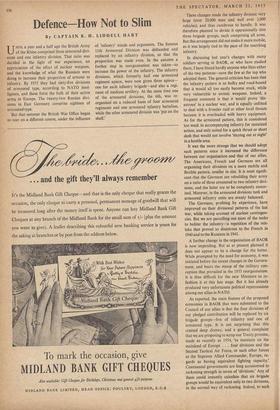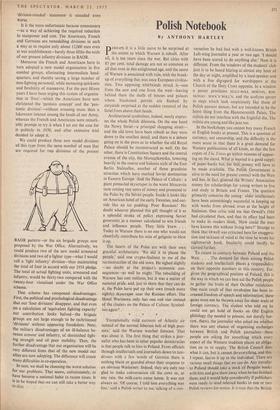Defence How Not to Slim
By CAPTAIN B. H. LIDDELL HART
U
NTM a year and a half ago the British Army j of the Rhine comprised three armoured divi- sions and one infantry division. That ratio was decided in the light of war experience, an appreciation of the effect of nuclear weapons, and the knowledge of what the Russians were doing to increase their proportion of armour to infantry. By 1955 they had sixty-five divisions of armoured type, according to NATO intel- ligence, and these form the bulk of their active army in Europe. The twenty-two Russian divi- sions in East Germany comprise eighteen of armoured type.
But that summer the British War Office began to veer on a different course, under the influence of 'infantry' minds and arguments. The famous 1 I th Armoured Division was disbanded and replaced by an infantry division, so that the proportion was made even. In the autumn a further step in reorganisation was taken—to increase the power of the infantry. The infantry divisions, which formerly had one armoured regiment apiece, were now given three apiece— one for each infantry brigade—and also a regi- ment of medium artillery. At the same time one of the armoured divisions, the 6th, was re- organised on a reduced basis of four armoured regiments and one armoured infantry battalion, while the other armoured division was 'put on the shelf.' These changes made the infantry division very large (over 20,000 men and well over 3,000 vehicles), and thus cumbrous to handle. It was therefore planned to divide it operationally into three brigade groups, each comprising all arms. But this arrangement did not make it more mobile, as it was largely tied to the pace of the marching infantry.
In discussing last year's changes with many soldiers serving in BAOR, or who have studied them, I have found hardly anyone who likes either of the two patterns—save the few at the top who adopted them. The general criticism has been that the infantry pattern is so bulky and road-bound that it would all too easily become stuck, while very vulnerable to atomic weapons. Indeed, a frequent comment is that it would prove 'dis- astrous' in a nuclear war, and is equally unfitted to deal with a frontier raid or other local threats because it is overloaded with heavy equipment. As for the armoured pattern, this is considered too weak in accompanying infantry for sustained action, and only suited for a quick thrust or short dash that would not involve 'staying out at night' in a hostile area.
It was the more strange that we should adopt such patterns since it increased the difference between our organisation and that of our allies. The Americans, French and Germans are all organising their divisions on a more mobile and flexible pattern, smaller in size. It is most signifi- cant that the Germans are rebuilding their army on a ratio of three armoured to two infantry divi- sions, and the latter are to be completely motor- ised. Morever, in the armoured divisions tank and armoured infantry units are evenly balanced.
The Germans, profiting by experience, have improved on their divisional patterns of the last war, while taking account of nuclear contingen- cies. But we are parcelling out most of the tanks to bolster the infantry—a repetition of the mis- take that proved so disastrous to the French in 1940 and to the Russians in 1941.
A further change in the organisation of BAOR is now impending. But as at present planned it does not appear to be a change for the better. While prompted by the need for economy, it was initiated before the recent changes in the Govern- ment, and bears the stamp of the military con- ception that prevailed in the 1955 reorganisation. It is thus difficult for the new Ministers to re- fashion it at this late stage. But it has already produced very unfortunate political repercussions among our allies in NATO.
As reported, the main feature of the proposed economies in BAOR that were submitted to the Council of our allies is that the four divisions of our pledged contribution will be replaced by six brigade groups—five of infantry and one of armoured type. It is not surprising that this created deep dismay, and a general complaint that we are proposing to scrap our Treaty promise, made as recently as 1954, `to maintain on the mainland of Europe . . . four divisions and the Second Tactical Air Force, or such other forces as the Supreme Allied Commander, Europe, re- gards as having equivalent fighting capacity.' Continental governments are long accustomed to reckoning strength in terms of 'divisions.' Any of them could instantly calculate that six brigade groups would be equivalent only to two divisions, in the normal way of reckoning. Indeed, to such `division-minded' statesmen it sounded even worse.
It is the more unfortunate because unnecessary —as a way of achieving the required reduction in manpower and cost. The Americans, French and Germans are remodelling divisions in such a way as to require only about 12,000 men even at war establishment—barely three-fifths the scale of our present infantry divisions in BAOR.
• Moreover the French and Americans have in turn adopted a new model organisation in five combat groups, eliminating intermediate head- quarters, and thereby saving a large number of non-fighting personnel, while increasing quickness and flexibility of manoeuvre. For the past fifteen years I have been urging this system of organisa- tion in 'fives'—which the Americans have now christened the 'pentana concept' and the 'pen- tomic division'—without arousing more than a lukewarm interest among the heads of our Army, whereas the French and Americans were remark- ably prompt to try it when I set out the case for it publicly in 1950, and after extensive trial decided to adopt it.
We could produce three new model divisions of this type from the same numbei. of men that are required for two divisions of the present BAOR pattern—or the six brigade groups now proposed by the War Office. Alternatively, we could produce two of the new model armoured divisions and two of a lighter type—what I would call a 'light infantry' division—thus maintaining the total of four in accord with our 1954 pledge. The total of actual fighting units, armoured and infantry, would be thirty-two compared with the twenty-four visualised under the War Office scheme.
That scheme has compound disadvantages. First, the political and psychological disadvantage that our 'four divisions' disappear, and that even ,on a calculation of `equivalent fighting capacity' our contribution looks halved—the brigade groups are not large enough to be rechristened 'divisions' without appearing fraudulent. Next, the military disadvantages of an ill-balance be- tween armour and infantry, of diminished fight- ing strength and of' poor mobility. Then, the further disadvantage that our organisation will be very different from that of the new model our allies are now adopting. The difference will create many difficulties in co-operation.
In sum, we shall be choosing the worst solution for our problems. That seems, unfortunately, to have become a national habit in recent times. It is to be hoped that \we can still take a better way to slim.



































 Previous page
Previous page